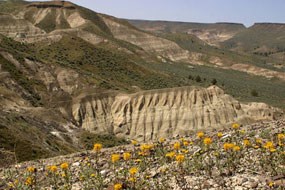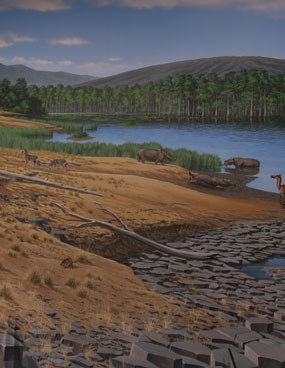
15 Million Years Ago, the rocks of the Mascall were laid down in a series of wide, level basins following a ferocious volcanic period.
The Mascall landscape consisted of several broad basins with lakes and meandering streams that formed atop the last of the basalt flows.
These deposits were subsequently covered by successive falls of ash from volcanoes to the west and from the much closer Strawberry volcanics to the east. Alternating between the tuffs – consolidated volcanic ash – are layers of ancient soils and stream deposits that provide evidence of a dynamic floodplain. Many of the vertebrate fossils from the Mascall are found in close association with a prominent layer, the 15 million-year-old “Mascall Tuff.” The deposits of the Mascall strata began when the flows of lava, known as the Picture Gorge Basalts, ceased. Although dramatic fluctuations in the global climate and regional volcanic activity continued, there were enough phases of moderate climate with ample rainfall and fertile soil to allow the growth of lush grasses and mixed hardwood forests. This savanna-like landscape was characterized by broad, level floodplains with scattered lakes.

These swift, long-legged, hoofed animals resembled their modern relatives: horses, camels, and peccaries. The Mascall environment also attracted newcomers: true cats crossed over from Asia, along with early elephant-like animals called gomphotheres. Other entire groups of animals, such as oreodonts,did not fare well in these new ecosystems, and their lineages went extinct. 
|
Last updated: January 3, 2018
